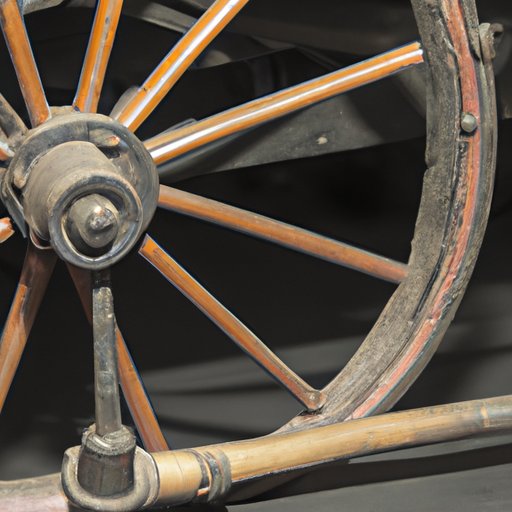Introduction
Wheels are an integral part of human life and have been used for centuries. The invention of the wheel was a crucial moment in human history that allowed for increased mobility, transportation, and trade. But when were wheels first invented? And how did they change human history?
A Historical Look at the Invention of Wheels
The earliest evidence of wheel use dates back to around 3500 BCE in ancient Mesopotamia. Archaeologists have discovered primitive potter’s wheels and stone wheels used for grinding grain. It is believed that these early wheels were made of wood and stone, although precise details are unknown.
During the Bronze Age (c. 3000 – 1200 BCE), the wheel began to be used more widely as a means of transportation. The introduction of the chariot—a two-wheeled vehicle drawn by horses—had a major impact on warfare and allowed for faster and more efficient movement of troops across large distances. These chariots spread throughout the Middle East, Europe, and Asia.
By the Iron Age (c. 1200 – 550 BCE), the wheel had become an important tool for transportation, agriculture, and commerce. Ox-carts were used to transport goods, and the use of wheels allowed for faster and easier movement of goods over long distances. This increased trade and commerce between different cultures, allowing for the exchange of ideas, resources, and technologies.

How the Wheel Changed Human History
The invention of the wheel had a profound impact on human history. It allowed for increased mobility and transportation, which led to improved agriculture and commerce. With improved transportation, people were able to move more quickly and efficiently, leading to the expansion of trade routes. This allowed for the exchange of goods, services, and ideas between different cultures, which in turn fostered economic growth and development.
The invention of the wheel also enabled new types of vehicles such as carts, carriages, and eventually automobiles. This allowed for even greater mobility and transportation, which further increased trade and commerce. Improved transportation also allowed for the expansion of empires, as it became easier for rulers to move their armies and resources over larger distances.

The Evolution of Wheel Technology
Over time, wheel technology has evolved and improved. From ox-carts to automobiles, wheels have become more sophisticated and advanced. Advances in materials used for wheels have also allowed for better performance and durability. Today, wheels are made from a variety of materials such as steel, aluminum, rubber, and plastic.
In addition to advances in materials, there have also been developments in the types of vehicles that use wheels. From bicycles to trains to airplanes, wheel technology has enabled us to move faster and farther than ever before. This has allowed for the expansion of global trade and has helped foster economic growth and prosperity.

Ancient Inventions That Impacted Human Mobility
The invention of the wheel was not the only innovation that impacted human mobility. The introduction of the horse-drawn carriage in the 15th century allowed for faster transportation over longer distances. This led to the expansion of cities and an increase in trade and commerce.
In the 19th century, the invention of the bicycle revolutionized transportation. It allowed people to travel farther and faster than ever before, and it was much cheaper than other forms of transportation. The invention of the steam engine in the 18th century also allowed for increased mobility, as it allowed for the construction of trains and ships.
The Mysteries Behind the Invention of the Wheel
Despite its importance, the exact origins of the wheel remain a mystery. We do not know who invented the wheel or how they came up with the idea. Some suggest that the idea of a wheel may have been inspired by the natural patterns found in nature, such as the sun and moon, or the circles formed by rolling logs. Others believe that the wheel was simply an accidental discovery, as people experimented with different materials and techniques.
Conclusion
The invention of the wheel is one of humanity’s most pivotal inventions. It changed the course of human history, leading to increased mobility and transportation, improved agriculture and commerce, and the expansion of trade routes. The wheel has also evolved over time, becoming more sophisticated and advanced. Despite its importance, the exact origins of the wheel remain a mystery.
The wheel is a testament to the ingenuity and creativity of human beings. It has allowed us to move faster, farther, and more efficiently than ever before, and it continues to be an essential part of our lives today.
(Note: Is this article not meeting your expectations? Do you have knowledge or insights to share? Unlock new opportunities and expand your reach by joining our authors team. Click Registration to join us and share your expertise with our readers.)
